How much starch is in rice and is it even in it?
Rice consumed in many countries, it is an important source of energy and nutrients. However, it is recommended to eat it in moderation so as not to harm the body.
The article will tell you if there is starch in rice and in what quantities it contains, what are the useful and harmful properties of rice starch.
The content of the article
Is there starch in rice grits
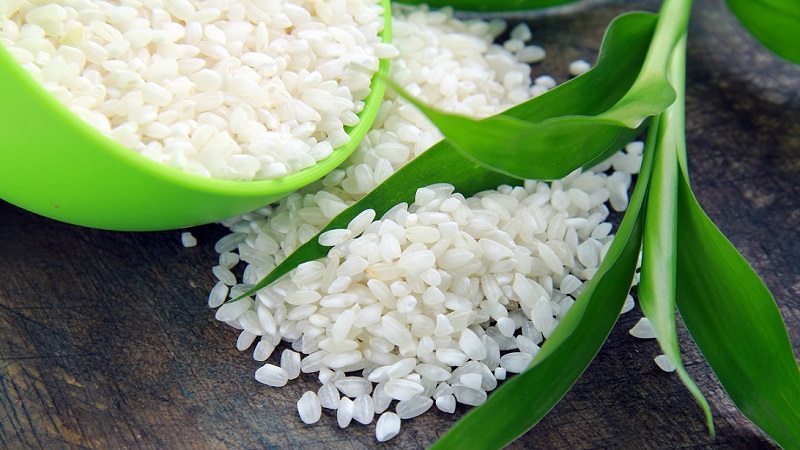
Rice starch is a naturally occurring polymer carbohydrate and a major component of rice. 100 g of rice contains 49.19 g of starch.
In its pure form, it is a fine-grained, tasteless white powder obtained from the processing of raw rice. It is inexpensive, hypoallergenic and non-toxic. It is an essential non-fragrance ingredient in body care products. Insoluble in water, consists of amylose and amylopectin.
Whole grains are difficult for the body to digest if not cooked properly. The top layer of grains, including brown rice, contains phytic acid, which can cause digestive upset if not neutralized.
Reference. Amylose and amylopectin have different properties that determine the texture and digestibility of rice.
Unlike other starches used in the food industry, rice is unique in its granule size and molecular structure.
Where is more starch - in rice or potatoes
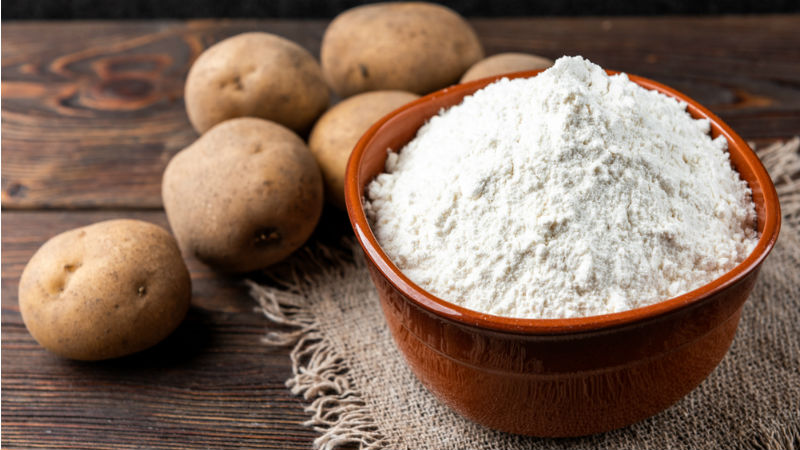
An average baked potato contains 29 g of carbohydrates, of which 2.9 g is fiber, 25 g is starch. Potatoes belongs to the category of starchy vegetables - more than 85% of carbohydrates that it contains are starch.
Rice has a higher carbohydrate content than potatoes: 46 g per 100 g of boiled product. Of these, 3.5 g is fiber, and the remaining 42.5 g is starch (more than 92% of rice carbohydrates). Medium-grained and long-grain varieties have similar characteristics and nutritional value.
Benefits of regular rice starch
Chemically speaking, starch has many useful properties - it is abundant and stable, non-hazardous and biodegradable. It is used primarily for food purposes, and is also used as a thickener.
This carbohydrate increases bone density by increasing the absorption of calcium and other minerals in adolescents and postmenopausal women. The laxative effect improves peristalsis and helps relieve constipation. In diabetes, indigestible fiber can lower post-meal blood sugar by slowing the absorption of glucose into the bloodstream.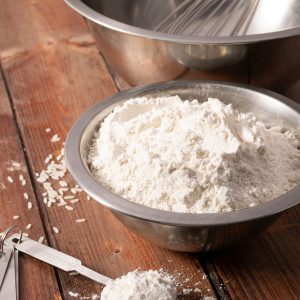
Rice starch feeds probiotic bacteria in the intestines and increases the production of short-chain fatty acids such as butyrate. Butyrate is the main "fuel" of colon cells.
This substance can increase insulin sensitivity. Low insulin sensitivity (insulin resistance) is believed to be one of the main risk factors for serious diseases such as metabolic syndrome, type 2 diabetes, obesity, heart disease, and Alzheimer's disease.
Many studies on the effects of rice starch on normal weight and obese people have shown that it increases satiety and reduces appetite. The inclusion of this complex carbohydrate in the diet optimizes triglyceride and cholesterol levels while decreasing fat mass. Its consumption has a positive effect on the intestinal absorption of calcium and iron.
White rice is rich in protein that is important for muscle development. As we age, bones lose density and become vulnerable to osteoporosis.Eating white rice strengthens bones and prevents muscle wasting.
It is interesting:
How to determine the starch content in potatoes.
The use of potato starch in folk medicine and in everyday life.
Harm and contraindications for use
Polished white rice has a higher glycemic index than brown rice, which means it breaks down into glucose more quickly. Foods with a high glycemic index increase the risk of developing type 2 diabetes. Regular consumption of white rice in excess amounts leads to the development of obesity.
Attention! 100 g of white rice corresponds to 86 g of sugar.
When this complex carbohydrate is digested, a paste-like substance is formed - a glue that is cooked on starch and used to glue paper. This substance clogs the microvilli in the small intestine, which are responsible for the absorption of beneficial elements.
The more often starchy foods, such as bread, are consumed, the more these microvilli become clogged. This negatively affects the digestive processes, and in particular, the assimilation of iodine. This threatens with chronic fatigue, drowsiness, decreased immunity, bad mood, etc. With frequent use of the product, the paste, which clogs the microvilli, hardens and eventually turns into fecal stones. They cause constipation and autoimmune diseases.
Contraindications to use:
- diseases of the pancreas in the acute stage;
- pregnancy - not recommended for stool problems;
- fungal diseases such as candidiasis;
- diabetes.
How rice starch is made
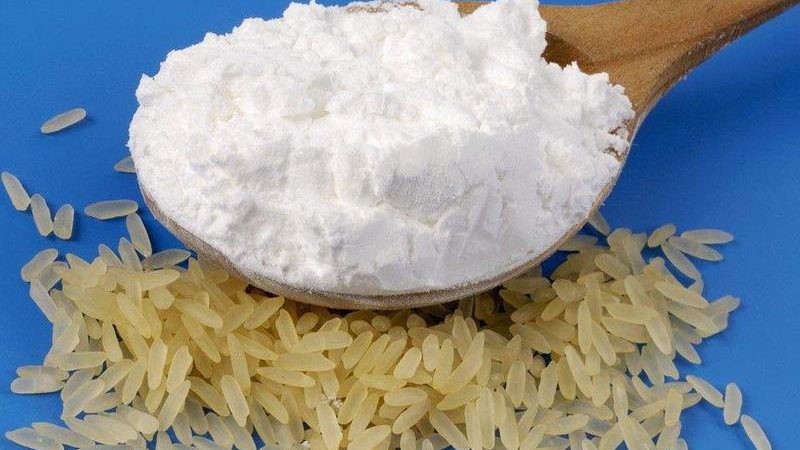
Starch production is the extraction of starch from plant sources. In the food industry, it is used as a starting material for the production of hydrolysates, dextrins.
In the manufacture of rice starch on an industrial scale, the starting raw material is husked rice: grain shells are removed from it, but longitudinal stripes are retained. The crushed grains are soaked for several hours in a solution of caustic soda, the alkali is washed off with water.
The softened grains are crushed with a large amount of caustic soda solution, the resulting mass is defended or fed to centrifugation in a drum... The starch layer is stirred with water (often with the addition of 0.25% formaldehyde solution), the resulting substance is dehydrated, washed on a continuous rotary vacuum filter, resuspended in water and dehydrated in a perforated centrifuge basket to a moisture content of about 35%.
A thick layer of moist starch is rolled out, after which it dries slowly and crumbles into pieces in the form of crystals.
Reference. Resistant starches are often destroyed during cooking.
How to apply this substance
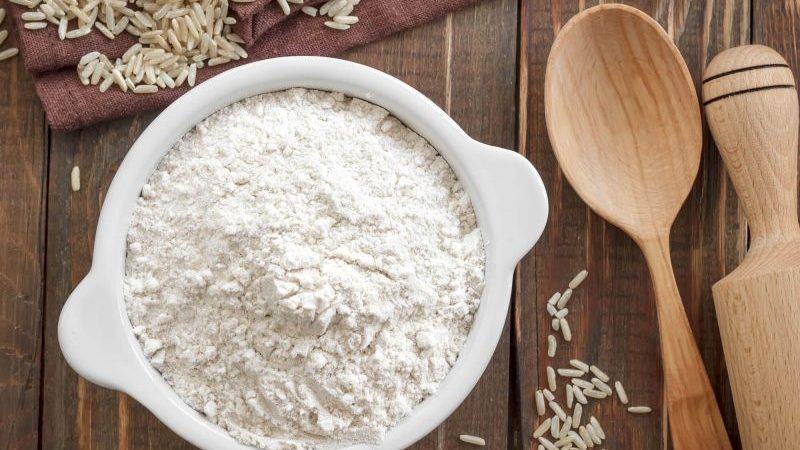
The use of rice starch is limited by its higher price compared to corn, wheat and potato starch. It is used as a gelatin substitute in white sauces and puddings, dairy products, and in the perfume industry.
Rice starch belongs to the group of highly digestible carbohydrates, which makes it a popular ingredient in baby food. From the age of six months, the baby's gastrointestinal system is able to break down carbohydrates, releasing glucose. Enveloping the stomach with a thin film does not allow negative effects of aggressive fruit and vegetable acids.
One of the most important characteristics of rice starch is its neutral taste. This allows it to be used in many dishes - meat, sauces, soups, baked goods, desserts.
This product is actively used in cosmetology, on its basis they create:
- bulk products for body and makeup;
- dry shampoos;
- antiperspirants;
- decorative cosmetics;
- creams;
- lotions;
- liquid talc.
Conclusion
Rice starch is a food product and an important ingredient in body care products.Thanks to its starch, rice promotes healthy digestion. However, excessive consumption of this substance can lead to obesity and iron deficiency anemia.